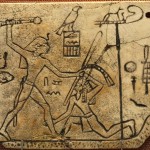
Editorial – Journal Edition 7 and Magazine Edition 9
A very warm welcome to the new edition of Egyptological. After a rocky few months following the damage that professional hackers inflicted on Egyptological, we have moved the site to a new host and are very pleased to be back. This is our first new edition since April, so we are delighted to be able […] [more…]

Vernacular Voices II: Ptolemaios, Phatres and Eirenais – Three Romano-Egyptians in Wadi Qash
Janet Robinson’s project Vernacular Voices is about ancient people living, travelling and most importantly communicating in writing in the Egyptian desert. Vernacular Voices I, published on Egyptological in May 2012 (http://egyptological.com/2012/05/31/vernacular-voices-8902), introduced a Romano-Egyptian called Phopis resting in a shady spot at Hans Winkler’s site RME21 (Robert Mond Expedition) in Wadi Qash. Vernacular Voices II discusses some hitherto unpublished graffiti signatures set in full sun at the celebrated ‘lost’ Hans Winkler rock-shelter RME18 which is also in Wadi Qash near the Roman garrisons of Krokodilo and Didymoi. [more…]

The Origin and Early Development of the Smiting Scene
The depiction of the king with mace raised above a helpless prisoner is one of the most prominent and enduring images of ancient Egypt. Although it has often been claimed that the origin for this iconic image lies in the Predynastic Era, this is unlikely. Not until the Narmer Palette do we see a possible model for dynastic developments of the image. These developments are traced here within the Early Dynastic Period [more…]
 By Andrea
By Andrea